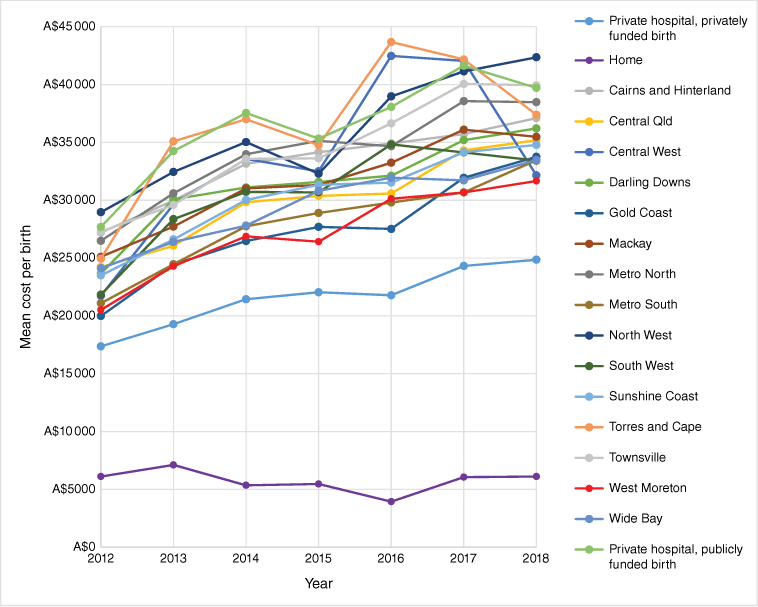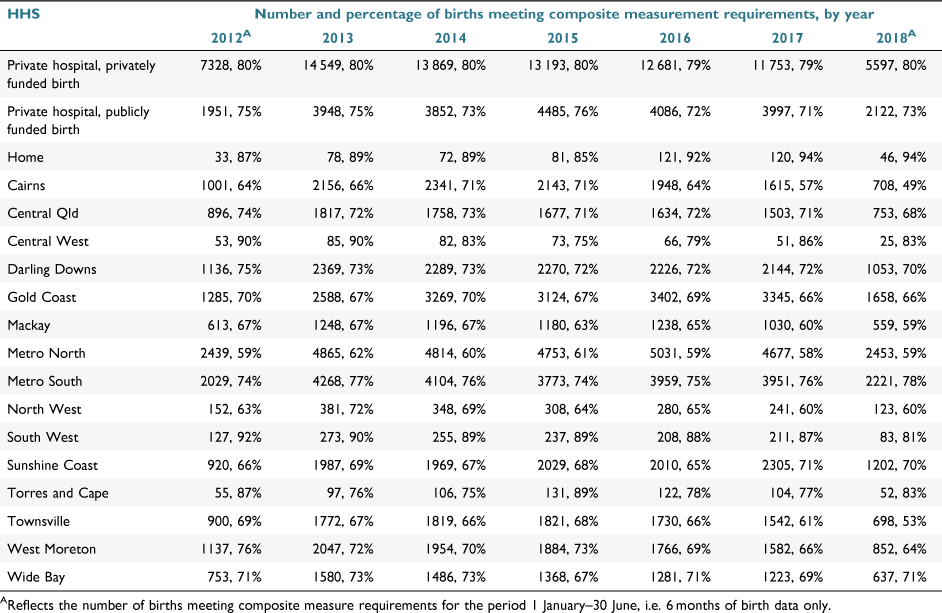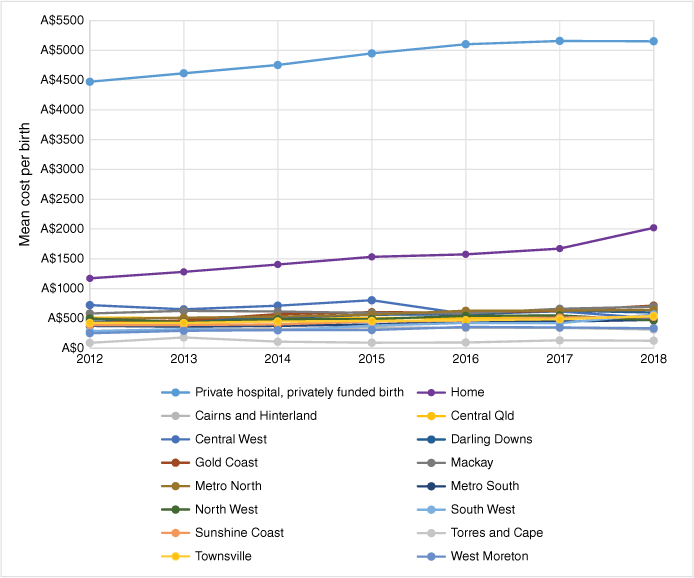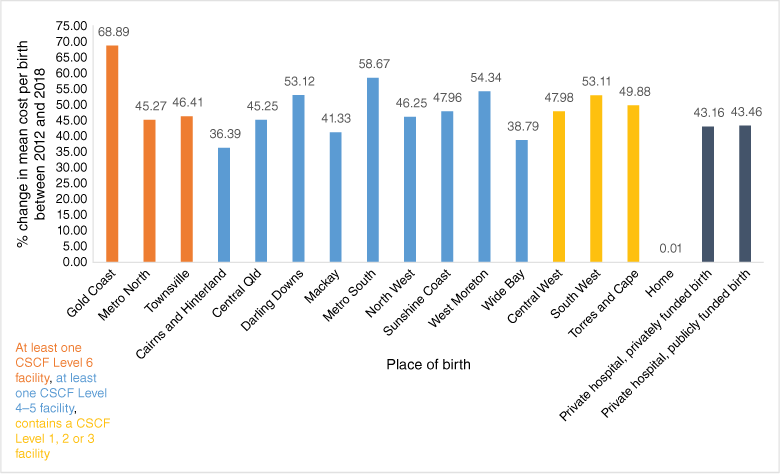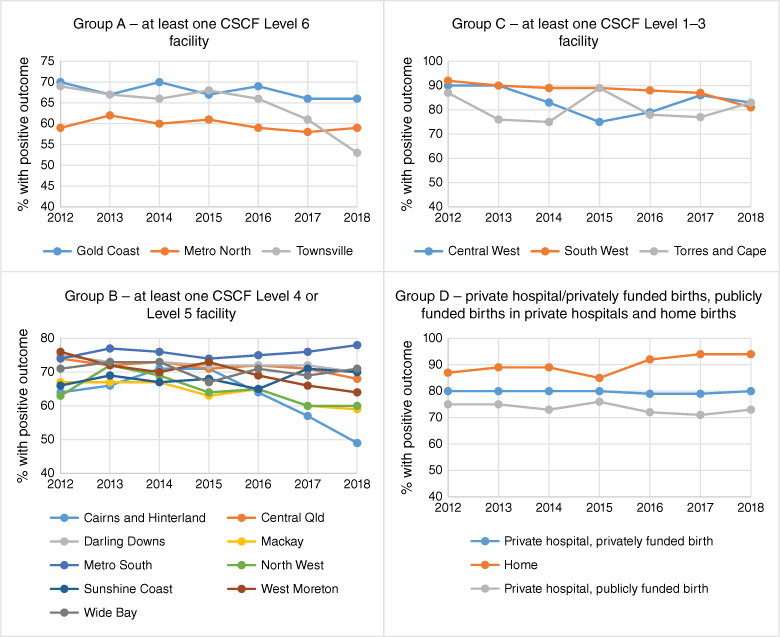Change in costs to funders of maternity care over time: an analysis of Queensland births
Bonnie Eklom A , Sally Tracy B and Emily Callander A *
A , Sally Tracy B and Emily Callander A *
A Monash Centre for Health Research and Implementation, School of Public Health and Preventive Medicine, Monash University, Melbourne, Vic., Australia.
B The Molly Wardaguga Research Centre, Charles Darwin University, Darwin, NT, Australia.
Australian Health Review 47(2) 148-158 https://doi.org/10.1071/AH22108
Submitted: 28 April 2022 Accepted: 11 January 2023 Published: 7 February 2023
© 2023 The Author(s) (or their employer(s)). Published by CSIRO Publishing on behalf of AHHA. This is an open access article distributed under the Creative Commons Attribution-NonCommercial-NoDerivatives 4.0 International License (CC BY-NC-ND)
Abstract
Objective To describe change in costs to different funders over time for women giving birth in Queensland between 2012 and 2018.
Methods A whole-of-population linked administrative dataset was used that contained all health service use in Queensland for women who gave birth between 1 July 2012 and 30 June 2018 and their babies. Aggregated costs for mother and baby from pregnancy to 12 months postpartum were used to compare the change in costs to funders over time.
Results There was an increase in mean total cost to all funders per birth in the public system and private system from 2012 to 2018. North West Hospital and Health Service (HHS) had the highest mean total cost (in Australian dollars) in 2018 (A$42 353), while home births had the lowest (A$6105). For the majority of HHSs the proportion of births with a positive birth outcome (as defined by a composite outcome measure) has remained largely static or declined during this time period. Cairns and Hinterland HHS and Townsville HHS had the largest declines of 15% and 16% respectively, while mean total cost to all funders rose 36.39% and 46.41%, respectively.
Conclusions There has been an increase over time across Queensland in the cost of childbirth in public hospitals and in the private system, while the cost of home birth has remained static. For most HHSs this increase in cost is also associated with little change or a decline in the percentage of births with a positive outcome. Increases in cost are therefore not being translated into better outcomes for women and their babies. Routine performance monitoring of cost, quality and safety should be adopted to ensure the provision of high value maternity care in Australia.
Keywords: administrative data, efficiency, maternity care funding, maternity services, performance monitoring, perinatal care, postpartum, pregnancy.
Introduction
It is widely recognised that public maternity services in Australia provide safe and high-quality care.1,2 However, this is a significant cost to the public health system. Care of childbearing women and newborns is one of the leading reasons for accessing public hospital services in Australia and a key driver of public hospital costs.3 Women in Australia also experience significant out-of-pocket expenditure even when accessing maternity care in public hospitals.4–6
A key contributor to the cost of childbirth in public hospitals is Australia’s relatively high rates (vs other high income countries) of birth interventions, many of which are not supported by best available evidence.7–9 For example, the Australian Quality and Safety Commission Fourth Australian Atlas of Healthcare Variation identified that in 2017 the rates for caesarean section without a medical or obstetric indication varied across states and territories (excluding the Northern Territory) from 13.3% to 19.3% for births at <37 weeks, 24.8–32.7% for births at <38 weeks and 42.8–56.1% for births at <39 weeks.10
Australia’s routine performance monitoring of maternity care occurs largely through the National Core Maternity Indicators.11 However, these are designed to capture the change in the safety and quality of services and do not include cost and efficiency domains or changes in cost over time. Similarly, Independent Hospital Pricing Authority (IHPA) costing exercises focus largely on the cost of maternity care at the activity level and do not encompass safety and quality domains across the whole journey of maternity care.
There is significant pressure on public hospital systems to constrain rises in the cost of public hospital care, including maternity care, due to caps on Commonwealth funding of public hospitals outlined in the National Health Reform Agreement.12 This is likely to be exacerbated by an anticipated increase in health service usage arising from delayed healthcare access for a range of conditions due to the impacts of coronavirus diseas 2019 restrictions.13–17 There is a clear need for routine performance monitoring that includes safety, quality and cost-efficiency domains if public hospitals are to continue to deliver high-quality care in a constrained fiscal environment.
The aim of this study was to describe the change in costs to different funders over time for women giving birth in Queensland between 2012 and 2018.
Methods
This study utilised the Maternity1000 dataset,18 a whole-of-population linked administrative dataset. All women who gave birth in Queensland between 1 July 2012 and 30 June 2018 were identified using the Queensland Perinatal Data Collection and their records linked to the Admitted Patient Data Collection; Non-admitted Patient Data Collection; Emergency Department Collection; Medicare Benefits Schedule (MBS); and Pharmaceutical Benefits Scheme (PBS) claims records from the onset of pregnancy to 12 months after the birth.
Costs to public hospital funders, including costs for publicly funded births that occur in a private hospital, were identified from the AR-DRG (Australian Refined Diagnosis Related Groups), URG (Urgency Related Groups) and Tier 2 clinic codes associated with inpatient, emergency department and outpatient services use, respectively, and the corresponding cost identified from the National Efficient Price reports released by the IHPA. Costs to private health insurers for private hospital inpatient events were identified from Private Hospital Reporting Bureau Annual Reports based on reported AR-DRG codes; and costs for health services provided in each inpatient event were identified from MBS claims records as the difference between the provider charge and the Medicare subsidy. Costs to Medicare and the PBS were identified directly from MBS and PBS claims records, respectively. Costs to individual women were identified from MBS and PBS claims records. All costs were adjusted to 2019–20 Australian dollars based on the Consumer Price Index.
Analysis
The mean cost of care from onset of pregnancy to 12 months after the birth for mothers and babies was identified by year (2012–18) and by the Hospital and Health Service (HHS) hospital that the mother birthed in. All costs were attributed back to the HHS of birth, given that care and events at the time of birth potentially have long-term effects on health outcomes, and thus health costs. HHSs were also grouped by the Clinical Services Capability Framework (CSCF) level of their maternity services. Costs during this time period were also presented by funder: public hospital funders (including those births that may have occurred in a private hospital but were publicly funded); Medicare; PBS; private health insurers; and individuals through out-of-pocket fees.
This study does not control for variations in clinical and demographic factors, given that the aim of this study is to capture the variation in total costs over time. If clinical and demographic factors mean that more resources are required to deliver maternity care in a given HHS (or private or home birth) then it is valid that this is captured in a total cost analysis.
Identification of outcomes
The study team used a composite birth outcome measure, based upon that reported in a previous study,19 which maps the variables collected in routine data to values and principles outlined in the Australian woman-centred care: Strategic directions for Australian maternity services document.20 A positive birth outcome was defined as any birth that had an absence of:
Stillbirth
Neonatal death (death within 30 days of birth)
Infant admission to special care or neonatal intensive care
Infant APGAR score <7 at 5 min
Hypoxic–ischaemic encephalopathy
Infant birth trauma (i.e. brachial plexus injury, fractured clavicle or humerus)
Intrauterine hypoxia
Other perinatal morbidity (i.e. meconium aspiration syndrome, congenital pneumonia or respiratory distress syndrome)
A third or fourth degree tear
Postpartum haemorrhage in the woman
Retained placenta
Rupture of uterus
Intrapartum haemorrhage in the woman.
The number of births defined as a positive birth outcome were then identified by year and HHS.
All analyses were carried out using SAS 9.4 (SAS Institute, Cary, NC, USA).
Ethics approval
Ethics approval was obtained from the Townsville Hospital and Health Service Human Research Ethics Committee (HREC; HREC/16/QTHS/223) and the Australian Institute of Health and Welfare (EO2017-1-338). In addition, we obtained Public Health Act approval (RD007377) for the study.
Results
Table 1 and Fig. 1 show the change in mean cost of health service use for women and their babies in Queensland by funding type and place of birth. Note that funding type includes both births in private hospitals that are privately funded and births in private hospitals that are publicly funded. Table 2 shows the change in the number of births meeting the requirements of the composite outcome measure over time. Across all HHSs, hospital and MBS costs are the major components of total cost. Public hospitals and private births (including private hospital, privately funded births and private hospital, publicly funded births) have experienced an increase in mean total cost from 2012 to 2018, while the cost of home births was static. North West HHS has the highest mean total cost in 2018 (A$42 353), while home births had the lowest total costs (A$6105) in 2018. From 2012 to 2018 private hospital, privately funded births and home births had the lowest mean total costs.
Fig. 2 shows the change in mean total out-of-pocket cost for women and their babies by place of birth. Mean out-of-pocket cost is highest for private and home births. There has been little increase in the mean total out-of-pocket cost for women giving birth in the public sector, with women giving birth in the Torres and Cape HHS having the lowest mean total out-of-pockets costs.
Fig. 3 shows the percentage change in mean total cost for women by place of birth, grouped by clinical services capabilities and specialisation. In Queensland, the CSCF for public and licensed private health facilities is a suite of documents that describes clinical and support services by service capability level, with the complexity and availability of services increasing from Level 1 (no planned births) to Level 6 (complex births).21 Level 6 facilities are typically located in major metropolitan or inner regional centres, Level 4–5 facilities in large rural or outer regional centres and Level 1–3 facilities in small rural, remote and very remote facilities.22
Fig. 3 indicates that across all CSCF groupings there has been a substantial increase in mean total cost from 2012 to 2018, in the range of 36–69%. HHSs containing a Level 1, 2 or 3 facility (Central West, South West and Torres Cape) have experienced higher percentage increases in costs than most of the HHSs with a Level 4 or 5 facility or Level 6 facility. Gold Coast HHS was the HHS that experienced the biggest percentage change in mean total costs from 2012 to 2018 (68.89%), followed by Metro South (58.67%) and West Moreton (54.34%) and Darling Downs (53.12%) HHSs. Private births have experienced a moderate percentage increase in cost from 2012 to 2018 (43.16%) while home births have experienced a negligible percentage increase in costs of 0.01%.
Fig. 4 shows the change in percentage of births that can be defined as a positive birth outcome by birth setting and by CSCF grouping. A comparison of Table 1, Figs 1, 3, 4 shows that although the mean cost of birth has increased in public hospitals and private hospitals, the percentage of positive birth outcomes has not seen a similar rise: positive birth outcomes have remained largely static or have declined across all HHS. As shown in Table 1, Fig. 3, mean total costs per birth for Cairns and Hinterland HHS rose 36.39% between 2012 and 2018, from A$27 201 to A$37 099.60, while the percentage of positive birth outcomes declined from 64% in 2012 to 49% in 2018. Similarly, the mean total cost per birth for Townsville HHS rose 46.41% from A$27 273 in 2012 to A$39 932 in 2018, while the percentage of positive birth outcomes declined from 69% in 2012 to 53% in 2018. West Moreton and South West HHSs also experienced a decline in positive birth outcomes in excess of 10% between 2012 and 2018 (West Moreton 76–64%; South West 92–81%) while mean cost increased in excess of 50% (West Moreton 54.35%, South West 53.11%). Metro South and Sunshine Coast were the only HHSs for which the percentage of positive birth outcomes increased between 2012 and 2018 (from 66% to 70% for Sunshine Coast and from 74% to 78% for Metro South). All other HHSs experienced a decline in positive birth outcomes between 2012 and 2018 of 0–10%, irrespective of CSCF level, while mean total cost per birth rose between 38% and 68%. HHSs with at least one CSCF Level 1–3 facility have a higher percentage of positive birth outcomes across 2012–2018 (in the range of 75–92%) than HHSs with a Level 6 (53–69%) or at least one Level 4–5 facility (49–78%). Only home births have seen an increase in the percentage of positive birth outcomes (87% in 2012 to 94% in 2018) as the mean cost of home births has remained constant (A$6104 in 2012 and 2018).
Discussion
The aim of this study was to identify the total costs associated with care delivered in the public system, private system or in the home to women and their babies from pregnancy to 12 months in Queensland, from 1 July 2012 to 1 July 2018. Costs are investigated from the perspective of the funder of this care and to highlight the change in actual cost of maternity care delivery to funders (whether this is the public health system, private health system or the patient). Funders of health care, including the public health system, largely cannot influence the clinical and demographic factors of the patients they treat. As such, clinical and demographic factors have not been controlled for when assessing the cost of maternity care delivery by funder/HHS, given that adjusting for clinical and demographic factors would in fact not be an accurate representation of the actual cost to funders of delivering care. We identified that there is considerable variation in costs dependent upon place of birth and that the cost of maternity care has increased over time. This study also demonstrated that these variations and increases in cost do not appear to be correlated with geography or clinical services capabilities and specialisations. All HHSs experienced an increase in total costs from 2012 to 2018, and when grouped by clinical services capabilities and specialisations there was no evidence of a different pattern of cost increases between the CSCF groupings. As outlined above, this study did not adjust for clinical and demographic factors, therefore it is possible that these increases in costs may be attributable to changes in clinical and demographic factors in women who gave birth during the study period of 2012–18.
This study also considered the value of maternity care provided in HHSs, private and home birth settings by use of a composite outcome measure. This composite measure defines positive birth outcomes that should be achievable for all women and that correlate with the four values of safety, respect, choice and access outlined in Australia’s national maternity strategy.19 Calculating the percentage of positive birth outcomes for all women by place of birth and comparing this with the mean cost of birth provides a measure of the value of maternity care provided in each setting and takes into account variations in clinical and demographic factors. When women may require additional resources to achieve a positive birth outcome (e.g. a caesarean section) no penalty is applied to the given maternity service because costs are attributed to a positive birth outcome, that is, the maternity service is providing high value care.23 However, if a maternity service is consuming a high level of resources and not achieving a positive birth outcome, then the maternity service may be providing low value care.23
Between 2012 and 2018, Townsville HHS, Cairns and Hinterland HHS, and the West Moreton and the South West HHSs had a substantial decrease (>10%) in the percentage of positive birth outcomes, despite experiencing a rise in mean total cost per birth (<35%). Home births, Metro South and Sunshine Coast HHSs were the only birth settings for whiche the percentage of positive birth outcomes increased between 2012 and 2018 (from 66% to 70% for Sunshine Coast, 74–78% for Metro South and from 87% to 94% for home births).
All other HHSs had a decline in the percentage of positive birth outcomes to a greater or less extent, while the mean total cost of birth has increased (e.g. for Central Queensland the percentage of positive birth outcomes declined from 74% to 68% between 2012 and 2018 while the mean total cost of birth increased by 45.25%). This may indicate that these HHSs have had to consume greater resources to deliver positive birth outcomes, perhaps associated with changing clinical or demographic factors associated with their catchment population. The notable exception to this trend is home births, for which the costs have remained stable and outcomes improved. When placed in the context of Australia’s relatively high rates (vs other high income countries) of birth interventions, many of which are not supported by best available evidence and do not result in better health outcomes,7–9 this decline in the percentage of positive birth outcomes may be indicative of less than optimal resource use.
Conclusion
This study has shown an increase over time across Queensland in the costs associated with health care delivered in public hospitals, in the private system and in the home for women and their babies from onset of pregnancy to 12 months after the birth. This increase in costs is associated with a decrease in the percentage of births with a positive outcome (as defined by a composite outcome measure). Further effort should be made to identify the variables associated with low value care and to identify cost-effective, high value models of care that can deliver positive birth outcomes.
Data availability
The data that support this study were obtained from the Australian Institute of Health and Welfare and Queensland Health by permission/licence. Data will be shared upon reasonable request to the corresponding author with permission from the Australian Institute of Health and Welfare and Queensland Health.
Conflicts of interest
The authors declare that they have no conflicts of interest.
Declaration of funding
This research did not receive any specific funding.
References
[1] Kennedy HP, Balaam M-C, Dahlen H, et al. The role of midwifery and other international insights for maternity care in the United States: an analysis of four countries. Birth 2020; 47 332–345.| The role of midwifery and other international insights for maternity care in the United States: an analysis of four countries.Crossref | GoogleScholarGoogle Scholar |
[2] Organisation for Economic Cooperation and Development (OECD). OECD health statistics 2021. Paris: OECD; 2018.
[3] Independent Hospital Pricing Authority (IHPA). Bundled pricing for maternity care. Final report of IHPA and the Bundled Pricing Advisory Group. Canberra: IHPA; 2017.
[4] Adams J, Steel A, Frawley J, et al. Substantial out-of-pocket expenditure on maternity care practitioner consultations and treatments during pregnancy: estimates from a nationally-representative sample of pregnant women in Australia. BMC Pregnancy Childbirth 2017; 17 114
| Substantial out-of-pocket expenditure on maternity care practitioner consultations and treatments during pregnancy: estimates from a nationally-representative sample of pregnant women in Australia.Crossref | GoogleScholarGoogle Scholar |
[5] Callander EJ, Topp S, Fox H, et al. Out-of-pocket expenditure on health care by Australian mothers: lessons for maternal universal health coverage from a long-established system. Birth 2020; 47 49–56.
| Out-of-pocket expenditure on health care by Australian mothers: lessons for maternal universal health coverage from a long-established system.Crossref | GoogleScholarGoogle Scholar |
[6] Callander E, Fox H. Changes in out-of-pocket charges associated with obstetric care provided under Medicare in Australia. Aust N Z J Obstet Gynaecol 2018; 58 362–365.
| Changes in out-of-pocket charges associated with obstetric care provided under Medicare in Australia.Crossref | GoogleScholarGoogle Scholar |
[7] Yu S, Fiebig DG, Scarf V, et al. Birth models of care and intervention rates: the impact of birth centres. Health Policy 2020; 124 1395–1402.
| Birth models of care and intervention rates: the impact of birth centres.Crossref | GoogleScholarGoogle Scholar |
[8] Shaw D, Guise J-M, Shah N, et al. Drivers of maternity care in high-income countries: can health systems support woman-centred care? Lancet 2016; 388 2282–2295.
| Drivers of maternity care in high-income countries: can health systems support woman-centred care?Crossref | GoogleScholarGoogle Scholar |
[9] Tracy SK, Tracy MB. Costing the cascade: estimating the cost of increased obstetric intervention in childbirth using population data. BJOG: Int J Obstet Gynaecol 2003; 110 717–724.
| Costing the cascade: estimating the cost of increased obstetric intervention in childbirth using population data.Crossref | GoogleScholarGoogle Scholar |
[10] Australian Commission on Safety and Quality in Health Care and Australian Institute of Health and Welfare. The Fourth Australian Atlas of Healthcare Variation. Sydney: Australian Government; 2021.
[11] Australian Institute of Health and Welfare. National Core Maternity Indicators 2017 Summary Report. Canberra: Australian Government; 2019.
[12] Council of Australian Governments. National Health Reform Agreement. Canberra: Australian Government; 2011.
[13] Queensland Government. Non-urgent elective surgeries postponed. 2022. Available at https://statements.qld.gov.au/statements/94231 [verified 22 March 2022].
[14] Australian Institute of Health and Welfare. Public hospitals worked to clear elective surgery backlog during 2020–21. 2022. Available at https://www.aihw.gov.au/news-media/media-releases/2021/january-1/public-hospitals-worked-to-clear-elective-surgery [verified 20 March 2022].
[15] Australian Institute of Health and Welfare. The first year of COVID-19 in Australia: direct and indirect health effects. Canberra: AIHW; 2021.
[16] White J, Cavenagh D, Byles J, et al. The experience of delayed health care access during the COVID 19 pandemic in Australian women: a mixed methods exploration. Health Soc Care Community 30 e1384–e1395.
| The experience of delayed health care access during the COVID 19 pandemic in Australian women: a mixed methods exploration.Crossref | GoogleScholarGoogle Scholar |
[17] Australian Institute of Health and Welfare. Cancer in Australia 2021. Canberra: AIHW; 2021.
[18] Callander EJ, Fox H. What are the costs associated with child and maternal healthcare within Australia? A study protocol for the use of data linkage to identify health service use, and health system and patient costs. BMJ Open 2018; 8 e017816
| What are the costs associated with child and maternal healthcare within Australia? A study protocol for the use of data linkage to identify health service use, and health system and patient costs.Crossref | GoogleScholarGoogle Scholar |
[19] Eklom B, Tracy S, Callander E. An exploration of potential output measures to assess efficiency and productivity for labour and birth in Australia. BMC Pregnancy Childbirth 2021; 21 703
| An exploration of potential output measures to assess efficiency and productivity for labour and birth in Australia.Crossref | GoogleScholarGoogle Scholar |
[20] Council of Australian Governments Health Council. Woman‐Centred Care: Strategic Directions for Australian Maternity Services. COAG Health Council. 2019.
[21] Queensland Health. Clinical Services Capability Framework for Public and Licensed Private Facilities Maternity Module. Brisbane, Australia: Queensland Government; 2014.
[22] Queensland Health. Rural Maternity Taskforce Report. Brisbane: Queensland Government; 2019.
[23] Sudhof L, Shah NT. In Pursuit of Value-Based Maternity Care. Obstet Gynecol 2019; 133 541–551.
| In Pursuit of Value-Based Maternity Care.Crossref | GoogleScholarGoogle Scholar |



